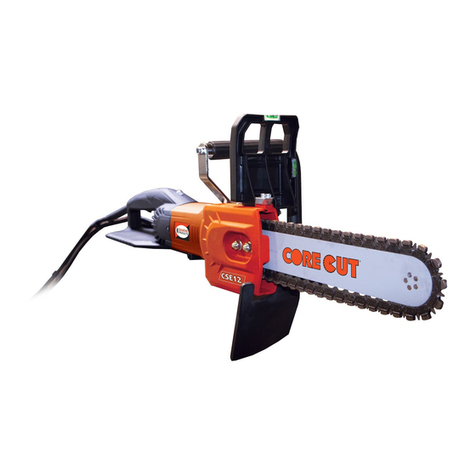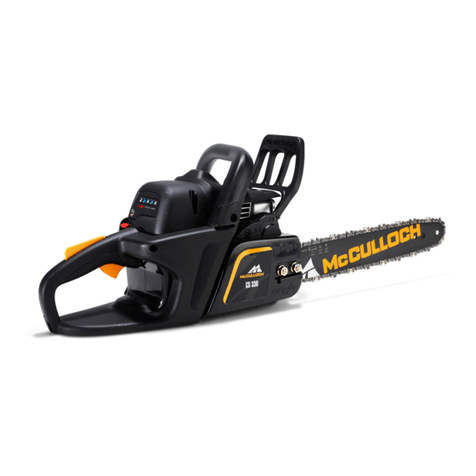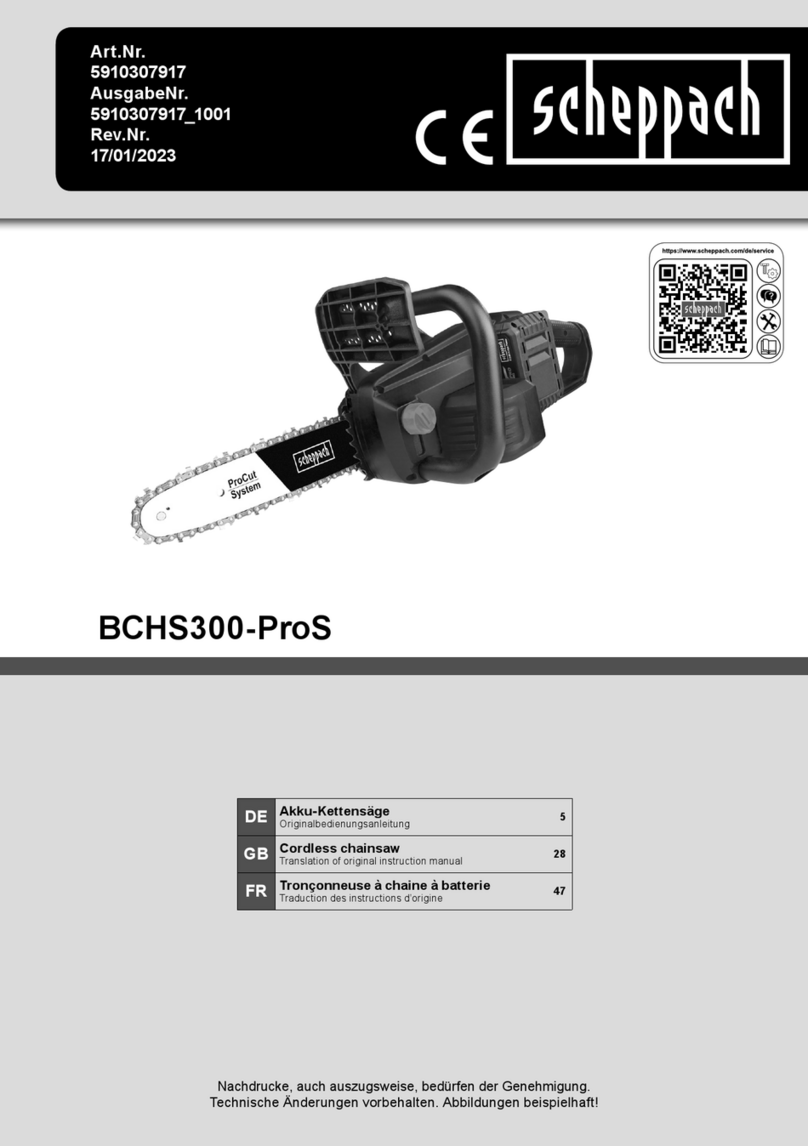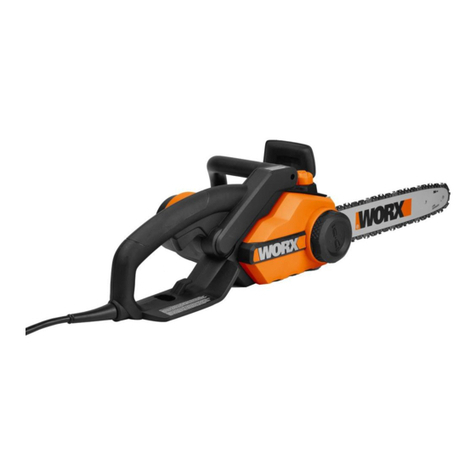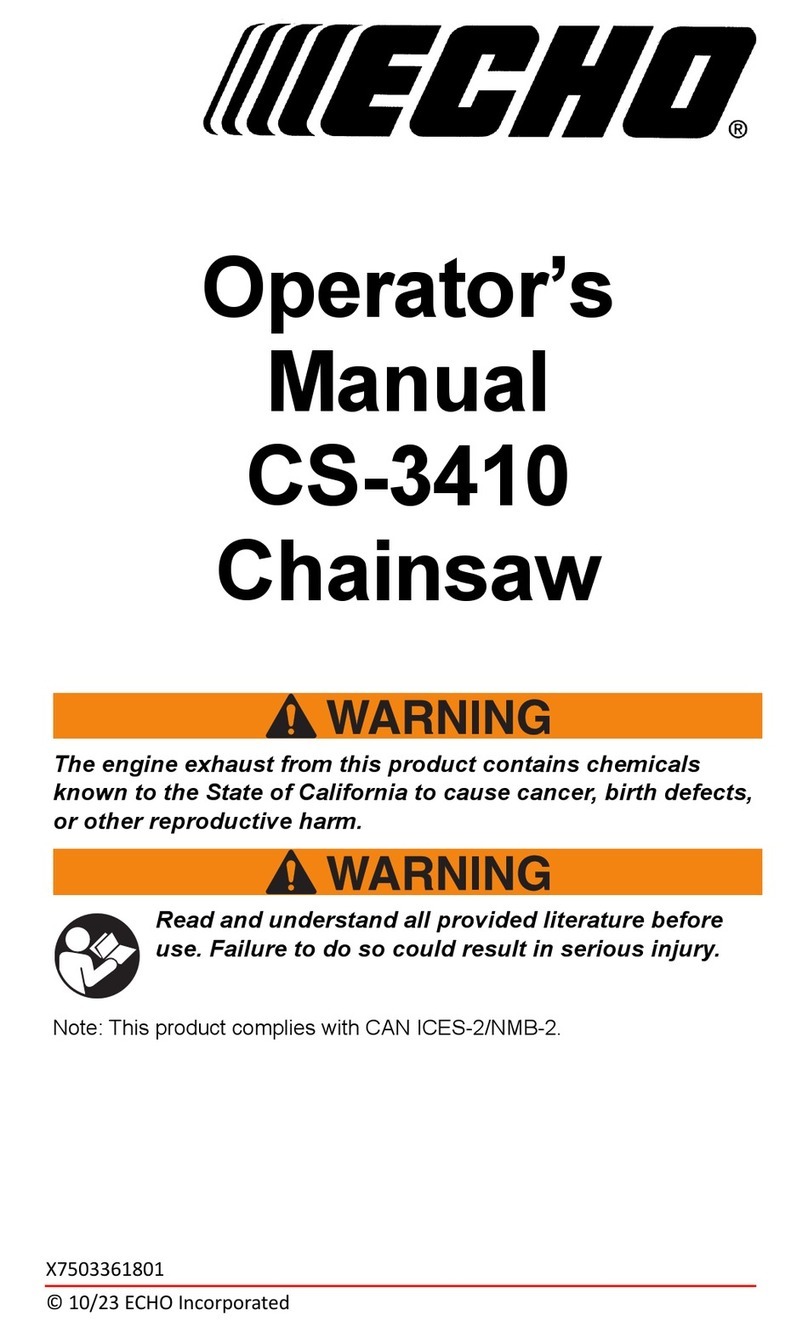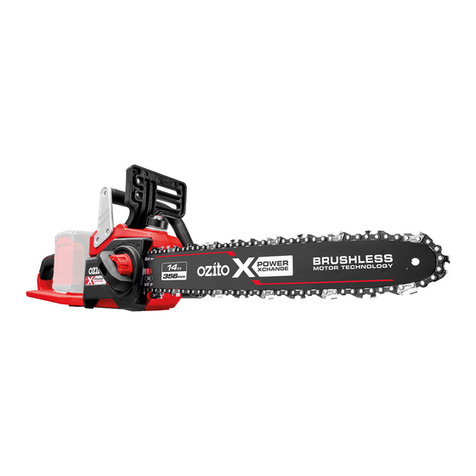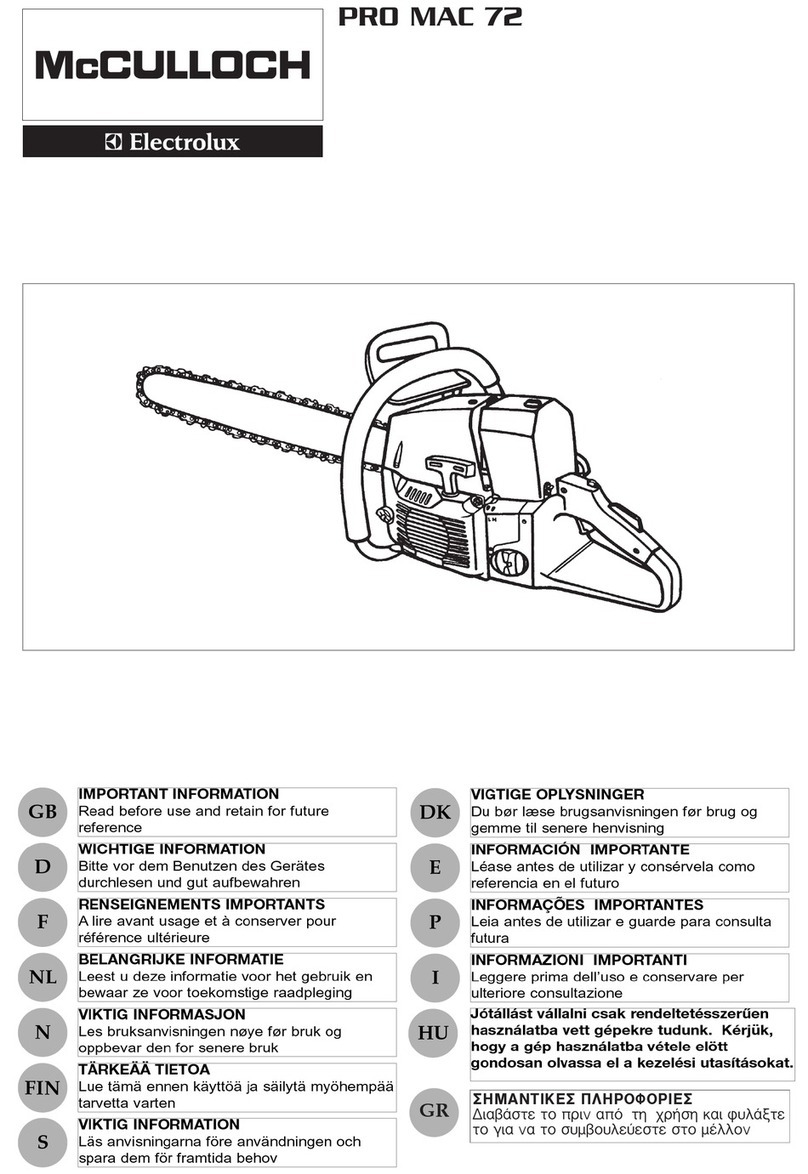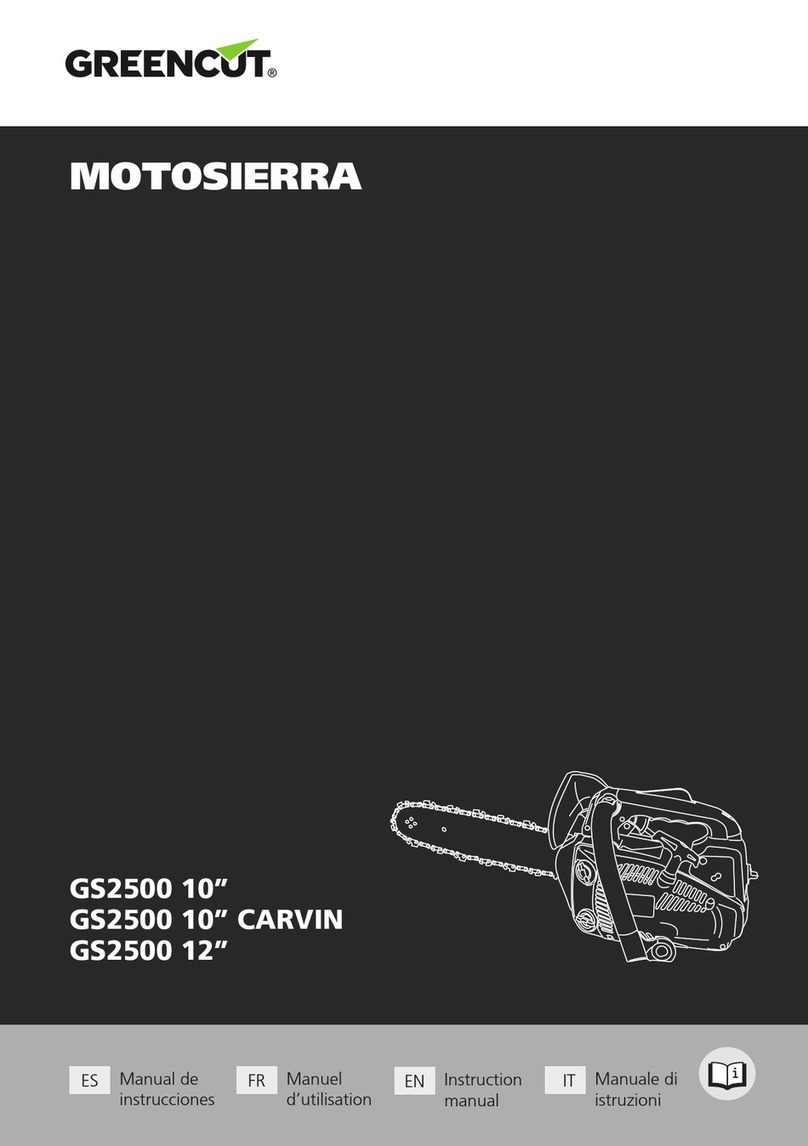Diamond Products CSE12 User manual

CORE CUT
OPERATOR’S MANUAL
CSE12
ELECTRIC CHAINSAW
Rev.: 21-01


EQUIPMENT DESIGNATION OPERATOR’S MANUAL
Table of Contents
Introduction..........................................................................................................................................4
Overview..........................................................................................................................................5
Equipment Specifications.................................................................................................................6
Safety Precautions ..............................................................................................................................7
Proposition 65..................................................................................................................................7
Spark Arrester Requirement.............................................................................................................7
Respiratory Hazards ........................................................................................................................7
General Safety.................................................................................................................................8
Chain Saw Safety ............................................................................................................................9
Transporting Safety..........................................................................................................................9
Lifting Safety....................................................................................................................................9
Operation...........................................................................................................................................10
Starting and Stopping Saw.............................................................................................................10
Starting ...................................................................................................................................10
Stopping..................................................................................................................................10
Overload and Overheat Protection.................................................................................................10
Making a Cut..................................................................................................................................10
Checklist.................................................................................................................................10
Beginning the Cut ...................................................................................................................10
Square Cut-outs......................................................................................................................11
Pipe Cutting ............................................................................................................................11
Water Supply ..........................................................................................................................11
Maintenance......................................................................................................................................12
General Maintenance.....................................................................................................................12
Sharpening a New or Glazed Chain...............................................................................................12
Choosing a Chain ...................................................................................................................12
Installing Guide Bar and Chain.......................................................................................................12
Tensioning the Chain..............................................................................................................12
Wearing Parts.........................................................................................................................14
Replacing the Drive Sprocket..................................................................................................14
Replacing Carbon Brushes .....................................................................................................14
Reference..........................................................................................................................................15
Appendix A ....................................................................................................................................15
Serial Number.........................................................................................................................15

EQUIPMENT DESIGNATION OPERATOR’S MANUAL
Introduction
Welcome to the Diamond Products family and thank you for choosing Diamond Products equipment.
At Diamond Products we are driven to ensure you are completely satisfied with your product and
continually strive to improve our product line so that we can offer you the best possible equipment in
the industry.
This operator’s manual is a critical document that provides pertinent information regarding the safety,
operation, maintenance, and care of your new equipment. Keep this manual available at all times.
Operate the equipment and all of its components according to this manual. Failure to comply with and
understand the following safety, operation and maintenance instructions can result in serious injuries
and/or death. All operators must be properly trained or supervised by experienced personnel prior to
using this equipment and should understand the risks and hazards involved. Diamond Products
discourages improper or unintended equipment usage and cannot be held liable for any resulting
damages.
Equipment modifications should be made by Diamond Products to ensure safety and design. Any
modifications made by the owner(s) are not the responsibility of Diamond Products and void all
equipment warranties if a problem arises as a result of the modification.
Refer to the Diamond Products Parts List for additional information and part diagrams. Refer to the
engine/motor manual and manufacturer as the primary source for all safety, operations, and
maintenance instructions regarding the engine/motor. Prior to operating, record the equipment’s serial
number, and the engine’s/motor’s model and serial numbers in Appendix A.
4

EQUIPMENT DESIGNATION OPERATOR’S MANUAL
Overview
5

EQUIPMENT DESIGNATION OPERATOR’S MANUAL
Equipment Specifications
Power Input
220 V: 3200 W
110 V: 3000 W
Voltage
220-240V~ 50/60Hz or 110-120V~ 50/60Hz (see machine nameplate)
No Load Speed min -1
10000
Max. Linear speed
20.65 m/s
Diamond Chain
25 links
Sprocket Pitch
3/8"
Guide Bar Nominal Size
330 mm (13")
Guide Bar Overall Length
382 mm (15")
Max. Depth of Cut
300 mm (11.8")
Protection Class
Class I
Dimensions (L x W x H)
630mm (930mm with guide bar) x 215mm x 280mm
Weight
8.0 kg (17.6 Lbs.), (8.94 kg (19.7 Lbs.) with guide bar & chain)
6

EQUIPMENT DESIGNATION OPERATOR’S MANUAL
Safety Precautions
Operate the equipment and all of its
components according to this manual. Failure
to comply with and understand the following
safety, operation and maintenance instructions
can result in serious injuries and/or death. All
operators must be properly trained or
supervised by experienced personnel prior to
using this saw and should understand the risks
and hazards involved. Diamond Products
discourages improper or unintended
equipment usage and cannot be held liable for
any resulting damages.
Equipment modifications should be made by
Diamond Products to ensure safety and
design. Any modifications made by the
owner(s) are not the responsibility of Diamond
Products and void all equipment warranties if a
problem arises as a result of the modification.
Refer to the Diamond Products Parts List for
additional information and part diagrams. Refer
to the engine manual and manufacturer as the
primary source for all safety, operations, and
maintenance instructions regarding the engine.
Prior to operating, record the saw’s serial
number, and the engine’s model and serial
numbers.
Notice: The information in this manual may
be updated at any time!
Safety Alerts
DANGER
Serious injuries and/or death will occur if
these instructions are not followed.
WARNING
Serious injuries and/or death could occur if
these instructions are not followed.
CAUTION
Mild and/or moderate injuries could occur if
these instructions are not followed.
Proposition 65
WARNING
Engine exhaust and some of its
constituents are known to the
State of California to cause
cancer, birth defects, and/or other
reproductive harm.
Spark Arrester Requirement
WARNING
In the State of California it is a violation of
section 4442 or 4443 to use or operate the
engine on any forest-covered, brush-
covered, or grass-covered land unless the
engine is equipped with a spark arrester, as
defined in section 4442, maintained in
effective, working order or the engine is
constructed, equipped, and maintained for
the prevention of fire pursuant to section
4443.
Respiratory Hazards
WARNING
Concrete cutting produces dust and fumes
known to cause illness, death, cancer,
respiratory disease, birth defects, and/or
other reproductive harm. Safety protection
techniques include, but are not limited to:
•Wearing gloves.
•Wearing safety goggles or a face
shield.
•Using approved respirators.
•Washing work clothes daily.
•Using water when wet cutting to
minimize dust.
•Washing the hands and face prior to
eating/drinking.
For additional safety and self-protection
information contact your employer, the
Occupational Safety and Health
Administration (OSHA), and/or The
National Institute for Occupational Safety
and Health (NIOSH).
7

EQUIPMENT DESIGNATION OPERATOR’S MANUAL
General Safety
•Read and understand all safety,
operations, and maintenance instructions
provided in this manual prior to operating or
servicing the saw.
•Keep equipment components clean and
free of slurry, concrete dust, and debris.
•Inspect water hoses prior to operating the
equipment. Clean, repair, or replace
damaged components.
•Raise the equipment to a proper height for
access when working underneath the
equipment. Use chocks to block the
wheels, and fit blocks or jacks under the
frame edges.
•When using a jack to raise the equipment,
place the jack against a solid, flat area
under the frame base to properly support
the equipment.
•Repair the equipment immediately when a
problem arises.
•Replace equipment decals if unreadable.
•Dispose of all hazardous waste materials
according to city, state, and federal
regulations.
•Always have a phone nearby, and locate
the nearest fire extinguisher and first aid kit
prior to operating the equipment.
•Operate the equipment wearing flame
resistant clothing.
•Always wear safety glasses when removing
retaining rings.
•Persons under the statutory age limit
should not operate the equipment.
•Keep all body parts away from rotating
machinery.
•Replace all guards and access panels
(unless stated otherwise) prior to operating
the equipment.
•Chock the wheels to help prevent
unnecessary movement.
DO NOT:
•Drop equipment, supplies, tools, etc., when
handling to help prevent injuries.
•Lift and carry equipment, supplies, tools,
etc., that are too heavy and/or cannot be
lifted easily.
•Operate the equipment without using the
appropriate safety equipment required for
the work task.
•Operate or service the equipment with any
clothing, hair, or accessories that can snag
in the machinery, which could lead to
serious injuries or death!
•Operate the equipment using attachments
not associated with or recommended for
the equipment.
•Operate the equipment around combustible
materials or fumes to prevent
fires/explosions.
•Operate the equipment with anyone near
the work area or within the direct line of the
blade.
•Operate the equipment until all
unnecessary materials have been removed
from the work area.
•Operate the equipment with loose nuts,
screws, and bolts.
•Operate the equipment when ill or fatigued.
•Operate the equipment under the influence
of drugs and/or alcohol.
•Operate the equipment on steep slopes.
•Cut concrete with guards and access
panels removed.
•Grease the equipment with the engine
running.
•Touch hot components when operating the
equipment.
•Leave the equipment unattended until the
engine is off and the blade has stopped
spinning.
•Place the equipment into storage until it
has cooled down.
•Service the equipment until it has cooled
down.
•Service the equipment with the engine
running.
8

EQUIPMENT DESIGNATION OPERATOR’S MANUAL
Chain Saw Safety
•Operate the equipment without using the
appropriate safety equipment required for
the work task.
•Always hold the chain saw with your right
hand on the rear handle and your left hand
on the front handle. Holding the chain saw
with a reversed hand configuration
increases the risk of personal injury and
should never be done.
•Hold the chain saw by insulated gripping
surfaces only, because the saw chain may
contact hidden wiring or its own cord. Saw
chains contacting a "live" wire may make
exposed metal parts of the chain saw "live"
and could give the operator an electric
shock.
•Wear eye protection. Further protective
equipment for hearing, head, hands, legs
and feet is recommended. Adequate
protective equipment will reduce personal
injury from flying debris or accidental
contact with the saw chain.
•Do not operate a chain saw in a tree, on a
ladder, from a rooftop, or any unstable
support. Operation of a chain saw in this
manner could result in serious personal
injury.
•Always keep proper footing and operate
the chain saw only when standing on fixed,
secure and level surface. Slippery or
unstable surfaces may cause a loss of
balance or control of the chain saw.
•Carry the chain saw by the front handle
with the chain saw switched off and away
from your body. When transporting or
storing the chain saw, always fit the guide
bar cover. Proper handling of the chain saw
will reduce the likelihood of accidental
contact with the moving saw chain.
•Follow instructions for lubricating, chain
tensioning and changing the bar and chain.
•Improperly tensioned or lubricated chain
may either break or increase the chance for
kickback.
•Cut concrete, masonry, and similar
materials only. Do not use chain saw for
purposes not intended. For example: do
not use chain saw for cutting wood, metal,
or plastic materials. Use of the chain saw
for operations different than intended could
result in a hazardous situation.
Transporting Safety
•Remove the blade prior to transporting the
equipment.
•Make sure the truck/trailer is in good,
working condition and sufficient to transport
•Raise the equipment to avoid damaging
components while moving up and down
ramps.
•Use extreme caution when guiding
the equipment up and down
ramps. Slowly drive the equipment
forward down the ramp. Slowly
back the equipment in reverse up the ramp.
Avoid standing directly downhill from the
equipment to prevent machine rollover.
•Place the equipment in neutral and turn off
the engine once the equipment is loaded in
the truck/trailer.
•Chock the wheels and secure the saw in the
truck/trailer prior to transporting.
•Refer to the Department of Transportation
(DOT) for additional transportation
recommendations.
•DO NOT tow the equipment behind a
vehicle.
•Close the fuel shutoff valve (applicable
models) when transporting.
•Drain the fuel tank when transporting long
distances.
•Use heavy-duty ramps that will support the
weight of the equipment and yourself when
loading or unloading.
Lifting Safety
•Move yourself and all others away from
the lifting area when hoisting the saw to
prevent being crushed.
•Secure the appropriate hoisting cables, straps,
and/or chains to the saw’s designated lift points
prior to hoisting.
•Never use the tie-down brackets (applicable
models) to lift the saw.
•DO NOT attempt to lift the saw irresponsibly.
9

EQUIPMENT DESIGNATION OPERATOR’S MANUAL
Operation
Starting and Stopping Saw
Starting
•This machine has a lock-off type switch.
First press the trigger release, then
squeeze the trigger switch to switch on. For
safety reasons, the switch is not possible to
lock on.
Stopping
•Release the trigger switch to stop the
machine. After the machine has been
switched off, the chain will still rotate for a
few seconds, take care that parts of your
body do not come into contact with the
chain while it is still rotating!
WARNING: Do not set the machine down until
the chain has stopped turning.
Overload and Overheat Protection
•When the tool is operating within its normal
load range, the LED load indicator will glow
green.
•When full load is reached, the load
indicator will flash red. If full load is
exceeded and sustained for too long, the
motor will shut down and the load indicator
will glow solid red. In this case, the motor
must be first shut off and then restarted.
•If the temperature of the motor gets
too high, the thermal protection will
shut the motor down. The switch must
be first shut off and then restarted.
When this happens, do not
immediately start cutting after
restarting the motor. Always run the
machine at no load for a few minutes
to return to a normal operating
temperature before continuing.
Making a Cut
Checklist
•Proper chain tension and ensure guide bar
nuts are tight
•Good condition of the chain, guide bar, and
drive sprocket
•Connect the water supply, check for leaks
and for proper water flow to the chain
•Ensure all safety equipment is in place and
functioning normally
•Mark the line of cut before beginning.
WARNING: A new operator should perform
some practice cuts under controlled conditions
to become familiarized with concrete chain saw
techniques. Experience with a wood cutting
chain saw does NOT qualify an operator to use
a concrete chain saw.
WARNING: Position the power supply cord so
that it will not become caught on worksite
obstacles.
CAUTION: Do not attempt to enter a kerf which
is narrower than the chain. This will damage
the diamond segments.
CAUTION: Avoid the chain being pinched in
the kerf. Plan the cut, and support the
workpiece if necessary, to avoid the kept
closing down on the chain as cutting
progresses.
NOTE: When cutting concrete with embedded
rebar, always cut in such a way that the chain
is cutting both concrete and rebar at the same
time. The concrete will help to keep the
diamond segments sharp.
Beginning the Cut
•With the chain running at full speed,
slowly approach the workpiece with
the nose of the guide bar and plunge
in. Hold the saw as straight as
possible.
•Start by making a shallow, 10 to 20mm
outline cut along the entire cutting line
with the nose of the guide bar. Then
plunge in deeper and complete the cut.
•While cutting, keep steady feed
pressure on the tool to prevent the
chain from chattering and bouncing.
Use enough pressure so that the
10

EQUIPMENT DESIGNATION OPERATOR’S MANUAL
motor audibly slows by about 20-30%.
This will keep the diamonds sharp.
Use the bumper spike for leverage to
assist in keeping pressure on the
cutting face.
Square Cut-outs
•When the tool is operating within its normal
load range, the LED load indicator will glow
green.
•When performing large square cut-
outs, after the initial shallow outline
cut, carefully hold the saw as squarely
as possible and plunge cut each of the
corners all of the way through.
•Make the bottom horizontal cut first,
then drive some wedges into kerf of
the bottom if the cut section is large
and heavy. Next, perform the 2 side
vertical cuts. Make the top horizontal
cut last.
•This cutting sequence will avoid the chain
being pinched by the workpiece.
WARNING: Ensure that appropriate
bracing is in place to controlfalling of the
concrete as the final cut is completed.
Concrete is extremely heavy and could
lead to severe injury if it falls in an
uncontrolled manner.
Pipe Cutting
•When cutting a concrete pipe,
support the pipe so that it will not
pinch the chain. Plunge straight
through the pipe, leaving a tab of
uncut material at the very top, which
will keep the pipe stable while cutting.
Cut this tab last to complete the cut.
Water Supply
•This tool must always be used with a
supply of clean water at a minimum
pressure of at least 1.5bar (20 psi). The
water serves as a coolant to avoid the
working surface of the diamond segments
from overheating and since it is not
possible to use oil, the water also serves as
the only lubricant available for the chain
and guide bar. Sufficient water pressure
will maximize chain life.
•To connect the water supply, attach the
quick-release water coupling to a water
hose and regulate the water flow by
adjusting the water feed valve.
CAUTION: Never use this tool without water,
the diamonds will overheat and the O-rings in
the chain will fail from the excessive heat.
WARNING: Check all connections of the water
feed system to
ensure there are no leaks. Inspect hoses and
other critical parts which could deteriorate.
WARNING: The maximum water pressure
should not exceed 70 psi (4 bar).
WARNING: Never allow water to enter the
motor.
NOTE: Contaminants in the water supply can
easily plug up the water nozzles in the water
feed system. Ensure that the supply water is
clean. If you find that there is no water flow to
the chain, then clean out the water feed
system on the machine.
NOTE: Use a wet vacuum to collect cooling
water if nearby objects could be damaged by
water.
11

EQUIPMENT DESIGNATION OPERATOR’S MANUAL
Maintenance
General Maintenance
•This machine operates in a harsh
environment with water and slurry. At the
end of each work day, thoroughly clean the
machine with water, then oil the bar and
chain with a water displacing spray such as
WD-40 to prevent rust. Ensure that the
water feed ports are clear. Chain tension
should be checked frequently and
readjusted immediately when necessary.
Inspect all parts of the saw for proper
function before each use. Pay special
attention to the condition of the chain,
inspecting each diamond segment for wear
or damage.
Sharpening a New or Glazed Chain
•If the chain is new, or if the chain’s
diamond segments become glazed,
sharpen by making a few cuts into an
appropriate alumina oxide or silicon carbide
dressing stone. Simply make shallow
plunge cuts into the stone as many times
as necessary to restore its cutting
performance. If a dressing stone is not
available, cutting into a highly abrasive
work material, such as cinder block will
also work.
Choosing a Chain
This chain saw uses a 25-link diamond
chain and a 13” guide bar. Chains with
different types of diamond segments are
available for different applications.
•Choose a chain with soft bond
segments for hard materials, such as
reinforced concrete. Trying to use a
chain with hard bond segments to cut
hard materials will lead to
unsatisfactorily slow cutting and the
chain will need to be sharpened many
times.
•Choose a chain with a hard bond
segments for softer, more abrasive
materials. Using a chain with soft
bond segments to cut soft materials
will lead to unnecessarily shorter
segment life. By choosing the correct
chain for the application, cutting will
be more effective and economical.
Installing Guide Bar and Chain
1. With the 2 side cover nuts removed and
the side cover removed, slacken the tension
adjustor by turning anticlockwise.
2. Slip the guide bar into position over the
studs with the hole engaged with the adjustor
pin. (the bar is symmetrical and may be
installed with either side up)
3. Place the chain around the drive
sprocket first, ensuring that the drive links
engage the sprocket teeth.
4. Starting from the drive sprocket end,
loop the chain around the guide bar nose
sprocket, ensuring that the drive links engage
with the guide bar groove and remain engaged
with the sprockets.
5. Place the side cover in position and
thread on the 2 side cover nuts, leaving them
finger tight only (to allow the tension adjustor to
be adjusted). They will be tightened fully after
tensioning according to the instructions below.
Tensioning the Chain
Note: Proper chain tension with a concrete
chain saw is much looser than with a wood
chain saw. It must be loose enough to run
freely with only water as its lubrication.
•An over tensioned chain will give
unnecessary load to the motor and will lead
to premature chain stretch, sprocket
damage, and spindle bearing damage.
•An overly slack chain could fly off the guide
bar and could also jump teeth on the drive
sprocket, leading to premature wear of the
sprocket and the chain’s drive links.
•In use, the chain must be readjusted if it
hangs below the guide bar 10mm or more
•To tension the chain, first loosen the 2 side
cover nuts and leave them finger tight.
CAUTION: attempting to turn the adjustor
12

EQUIPMENT DESIGNATION OPERATOR’S MANUAL
without loosening the side cover nuts could
result in damage to the adjustor mechanism.
•While holding the guide bar upward from
the nose end, turn the tension adjustor
clockwise to tighten.
•Rotate the chain by hand, grabbing the
chain by its diamond segments, to ensure
the chain rotates freely.
•WARNING: Wear gloves when handling
the chain and bar. Keep fingers away from
the edges of the guide bar rails. When
worn, they will have a very sharp edge.
•When the associated parts have some
wear, there will be some positions where
the chain is looser and other positions
where it is tighter. Find the tightest point,
and make the final adjustment at that
position.
•Tension is correct when the chain is free to
run around the guide bar, and the chain
will hang with the drive links just barely
engaging the guide bar groove at the
bottom center position.
•Once adjustment is satisfactory, the 2 side
cover nuts may be tightened. While still
holding guide bar upward, tighten the 2
side cover nuts firmly.
•CAUTION: Running the saw with the side
cover nuts loose will cause a hazardous
situation and could lead to damage to the
tension adjustor mechanism.
13

EQUIPMENT DESIGNATION OPERATOR’S MANUAL
Wearing Parts
1. Diamond Chain
The diamond segments will wear away with
normal use. In addition, the chain itself will
stretch due to accumulated wear of each joint
of the chain. Inspect each segment of the
chain before each use, noting any segment
damage or undue wear.
2. Guide Bar
The guide bar rails will wear from abrasion with
the chain. If the saw tends to cut to one side,
the rails have worn unevenly. The guide bar
rails can be re-squared by carefully sanding on
a bench mounted belt sander. If the chain’s
drive links are touching the bottom of the guide
bar grooves, the guide bar must be replaced.
Running a good chain on worn out guide bar
will prematurely wear out its drive links and the
motor will overload easily from the excessive
friction.
Extra life can be had from the guide bar by
flipping it over to the other side, since the
bottom wears faster than the top. It is a good
practice to flip the guide bar each time you
replace a chain. Generally, the guide bar will
need to be replaced after about 3 chains.
3. Drive Sprocket
Running a good chain on a worn-out sprocket
will prematurely wear out its drive links. After
about 3 chains, the drive sprocket will wear
away and need replacement.
Replacing the Drive Sprocket
To change the drive sprocket, first remove the
side cover, chain, and guide bar. Using circlip
pliers, remove the circlip, then the washer
which retain the drive sprocket, then lift the
sprocket off the splines. Replacement is the
reverse of removal.
Replacing Carbon Brushes
The carbon brushes are a normal wearing part
and must be replaced when they reach their
wear limit. This machine is equipped with auto-
stop carbon brush holders. If the machine
comes to a stop unexpectedly, the brushes
should be checked. The auto-stop brush
design protects the motor by stopping the
machine before the carbon brushes are
completely worn out.
Caution: Always replace the brushes as a pair.
1. Remove the screw and remove the
brush cover.
2. Using pliers rotate the brush spring out
of the way and slide the old carbon brush out
of the brush holder.
3. Unscrew the screw to remove the brush
lead. The old carbon brush may now be lifted
away.
4. Install a new brush. Installation is the
reverse of removal.
5. Replace the brush cover.
14

EQUIPMENT DESIGNATION OPERATOR’S MANUAL
Reference
Appendix A
Serial Number
Record the CSE12’s serial number below for future reference and customer service purposes.
Serial Number
15

NOTES
____________________________________________________
____________________________________________________
____________________________________________________
____________________________________________________
____________________________________________________
____________________________________________________
____________________________________________________
____________________________________________________
____________________________________________________
____________________________________________________
____________________________________________________
____________________________________________________
____________________________________________________
____________________________________________________
____________________________________________________
____________________________________________________
____________________________________________________
____________________________________________________
____________________________________________________
____________________________________________________
____________________________________________________
____________________________________________________
____________________________________________________
____________________________________________________
____________________________________________________
____________________________________________________
____________________________________________________
____________________________________________________
____________________________________________________
16

NOTES
____________________________________________________
____________________________________________________
____________________________________________________
____________________________________________________
____________________________________________________
____________________________________________________
____________________________________________________
____________________________________________________
____________________________________________________
____________________________________________________
____________________________________________________
____________________________________________________
____________________________________________________
____________________________________________________
____________________________________________________
____________________________________________________
____________________________________________________
____________________________________________________
____________________________________________________
____________________________________________________
____________________________________________________
____________________________________________________
____________________________________________________
____________________________________________________
____________________________________________________
____________________________________________________
____________________________________________________
____________________________________________________
____________________________________________________

NOTES
____________________________________________________
____________________________________________________
____________________________________________________
____________________________________________________
____________________________________________________
____________________________________________________
____________________________________________________
____________________________________________________
____________________________________________________
____________________________________________________
____________________________________________________
____________________________________________________
____________________________________________________
____________________________________________________
____________________________________________________
____________________________________________________
____________________________________________________
____________________________________________________
____________________________________________________
____________________________________________________
____________________________________________________
____________________________________________________
____________________________________________________
____________________________________________________
____________________________________________________
____________________________________________________
____________________________________________________
____________________________________________________
____________________________________________________


333 Prospect Street, Elyria, Ohio 44035
(440) 323-4616 •(800) 321-5336 •Fax (800) 634-4035
www.diamondproducts.com
Printed in U.S.A.
EQUIPMENT AND PARTS
WARRANTY
Diamond Products warrants all equipment manufactured by it against defects
in workmanship or materials for a period of one (1) year from the date of
shipment to Customer.
The responsibility of Diamond Products under this Warranty is limited to
replacement or repair of defective parts at Diamond Products’ Elyria, Ohio
factory, or at a point designated by it, of such parts as shall appear to us upon
inspection at such parts, to have been defective in material or workmanship,
with expense for transportation and labor borne by Customer.
In no event shall Diamond Products be liable for consequential or
incidental damages arising out of the failure of any Product to operate properly.
Integral units such as engines, electric motors, batteries, transmissions,
etc., are excluded from this Warranty and are subject to the prime
manufacturer’s warranty.
THIS WARRANTY IS IN LIEU OF ALL OTHER WARRANTIES, EXPRESSED
OR IMPLIED, AND ALL SUCH OTHER WARRANTIES ARE HEREBY
DISCLAIMED.
Other manuals for CSE12
1
Table of contents
Other Diamond Products Chainsaw manuals

